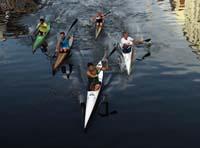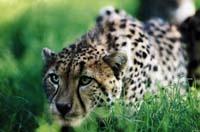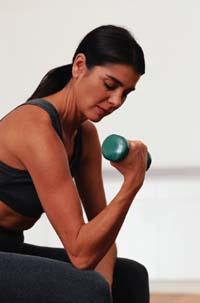Strength training, ready-to-use muscles

Thus, the training adapts to the characteristics of each sport. During training, the key skills for this sport are worked. And an athlete performs different types of training with these skills. As for strength, each sport has its own need. However, in general, in sports in which strength is a fundamental component, heavy loads are mobilized to the muscle, and in those in which it is necessary to maintain movement for a long time more than strength, as in long runs, minor loads are used in training, but movements are repeated more times.
In certain sports movements are needed as quickly as possible. But training for the muscle to move faster does not give much result, at least the experience has taught sports coaches (they get quickly to the border). Therefore, in these cases, muscle strength is also trained. The objective is, in short, to increase the power of a movement (to hit the ball by hand quickly and forcefully, for example), that is to say, to make more force per unit of time; if with the training time can not be reduced much -- if you can not accelerate the movement -- the force does increase much.
Julio Tous, trainer of elite athletes, currently works in a laboratory of the Karoliska Institute investigating strength training. According to Tous, "in short, the most important concept is power, because it is the combination of strength and speed. Our indicator is the power, since it shows us the performance of the athlete".
Adapting to difficulties

Training the force seeks to improve the performance of the athlete. By training the strength the muscle increases - called hypertrophy -, the cells that integrate it grow: they accumulate more proteins, the cell structure increases. This makes each cell able to contract with more strength and, therefore, all the muscle. This is very interesting in high power sports tests (in races of 100 meters, for example, stronger steps make running faster).
For long tests, however, it is not convenient to increase the muscle. Just look at a Maratonian: they are athletes with little musculature, light. And it is that the muscles, besides being an engine to move, is also a body, and in this case it is not convenient a heavy body and face in energetic terms. In long-term tests the limiting process is the contribution of oxygen to the muscle and a large muscle requires a lot of oxygen. Therefore, small, lightweight muscles are more effective for long-term testing.
However, training not only affects the muscle, but also affects the processes of the environment and, among other things, grows more blood vessels that accelerate the blood to the muscles. These tubes will bring to the muscle that oxygen so necessary during the long tests, as well as other substances (glucose fuel, water, ions...) essential in all types of sports.
The movement is achieved thanks to all these substances. And the work of the muscle is, in short, that: to create movement and for it it contracts and then relaxes, of course. But sometimes the muscle is contracted, for example, after a long sports session, or after death. The rigor mortis is, in short, a constant muscle contraction after which hides a molecule called ATP.

Ways of energy
Therefore, to move the muscle is necessary ATP. But in cells there are not many ATP molecules. Therefore, when the ATP is necessary, synthesis mechanisms are put into place.
The first mechanism is that of creatine phosphate. An ATP is obtained by creatine-phosphate molecule. This occurs in a single reaction, so this first mechanism is the fastest way to get the ATP. It is the fastest, but it doesn't last long: it gives the muscle a contraction of about ten seconds. For this reason, it is especially useful for short movements: race of one hundred meters, launch of weight, throwing faults to the ball, etc.

Several athletes take creatine as a dietary supplement to increase creatine-phosphate deposits. In fact, when ATP is obtained in the muscle from creatine phosphate, creatine is produced, reversible reaction: when there is enough ATP, it reacts with creatine and creatine phosphate is formed; when ATP is missing (for muscle activity), the reaction will tend in the opposite direction. But it is not shown that creatine considered as a supplement to the diet has that effect.
The second mechanism is glycolysis, starting from glucose or glycogen. From glucose a chain of ten reactions is obtained with two ATP. From glycogen three ATP are obtained after twelve reactions. Thanks to this glycolysis, the muscle is able to maintain an activity of 20-40 seconds (there is a lot of difference between a trained muscle and an untrained muscle).
One of the residual products of these reactions is lactic acid. In fact, it is a protection mechanism for the muscle, since it stops it before the energy reserves are exhausted. It is a well-known compound among athletes, since it is used to calculate the limit or maximum effort capacity of the athlete. In fact, in short and intense exercises it is a sign of fatigue, but it also occurs in longer exercises when the muscle does not get enough oxygen. When in a test the concentration of lactic acid in the blood of the athlete rises sharply, it means that it has reached its limit; if the athlete knows previously (through tests) this limit, it can calculate its optimal intensity during the sport test.
Both mechanisms are anaerobic, that is, oxygen does not participate in reactions. Therefore, the exercises that command these mechanisms are also called anaerobic; they are quick and short exercises. There are two other mechanisms for longer performances. These are aerobics, that is, they use oxygen to burn glucose and fat.

In this case, the mechanism is maintained until the fuel (glucose) is exhausted, not as in previous occasions. This poses a risk: once glucose is exhausted, the athlete suffers a weakness. There is no more to see how much the performance of cyclists is reduced when the flaqué arrives. This is due to the lack of glucose.
And finally, the fourth mechanism is the slower of all: the use of fat as fuel. Its slowness is due, on the one hand, to the mobilization of fat and, on the other, to the complexity of the process of obtaining ATP. But the largest number of ATP is obtained by: 130 molecules.
The best thing is that this mechanism is maintained as soon as possible. Fat is never a limit, according to Jon Irazusta, professor at the Faculty of Medicine of the UPV: "The thinnest person can also run three days using his body fat as fuel. That's why athletes try to have the least amount of fat possible."

The athlete loses fat during training, in which he also helps to take care of the diet, even if he does short exercise sessions. And according to Jon Irazusta, "it is wrong that to burn fat you have to make long attempts: for three or four minutes the muscle that is working begins to burn fat. It is true that as the exercise session continues to continue, the main mechanism for obtaining ATP is shifting from the first to the fourth, but from practically the same principle of activity there are several mechanisms that work simultaneously."
The stress, friend and enemy of the athlete
Running sessions, weight spins, stretches... training is related to exercise. But it makes much more sense. The diet, for example, is part of training and, of course, rest and sleep. A proper diet, rest and sleep are necessary to assimilate training.
Assimilating the training is adapting the muscle for exercise: more mitochondria are created in cells, new blood vessels are created... in short, it fixes the damage that the body has caused physical exercise. In fact, physical exercise is a stress. Stress causes the secretion of a hormone called cortisol and cortisol causes the break of proteins to obtain glucose.

Therefore, to assimilate the training is produced by stress
This breakage of proteins must be compensated. To do this, the main ingredients of the recipe are: On the one hand, the diet, which through food is partially compensated for the lack of glucose and proteins. And on the other hand, rest and sleep, since when sleeping is synthesized more growth hormone. The growth hormone has an anabolic effect, that is, it stimulates the production of proteins. So if an athlete sleeps little, as he trains, instead of having better results, he gets worse.
It is true that there are small traps for this kind of thing. For example, take substances with anabolic effects (testosterone and derivatives). The anabolizers are known for their muscular effect in the musculation rooms, but they also have another interesting effect, according to Jon Irazusta: they help to recover. They solve fractures of muscle fibers, create new red blood cells, etc. So, you don't need so much rest and sleep to assimilate the training, you can train more and the results get faster.

With these anabolizers, spectacular results are obtained. They are very interesting from the medical point of view. However, if an athlete does not want to get into trouble -- the disturbances bring stress and remember that stress reduces performance -- it is better to be away from them, practice with sportiness and let the body enhance the anabolic ones it produces.
Thanks to Jon Irazusta, from the UPV, for helping you prepare the article.






